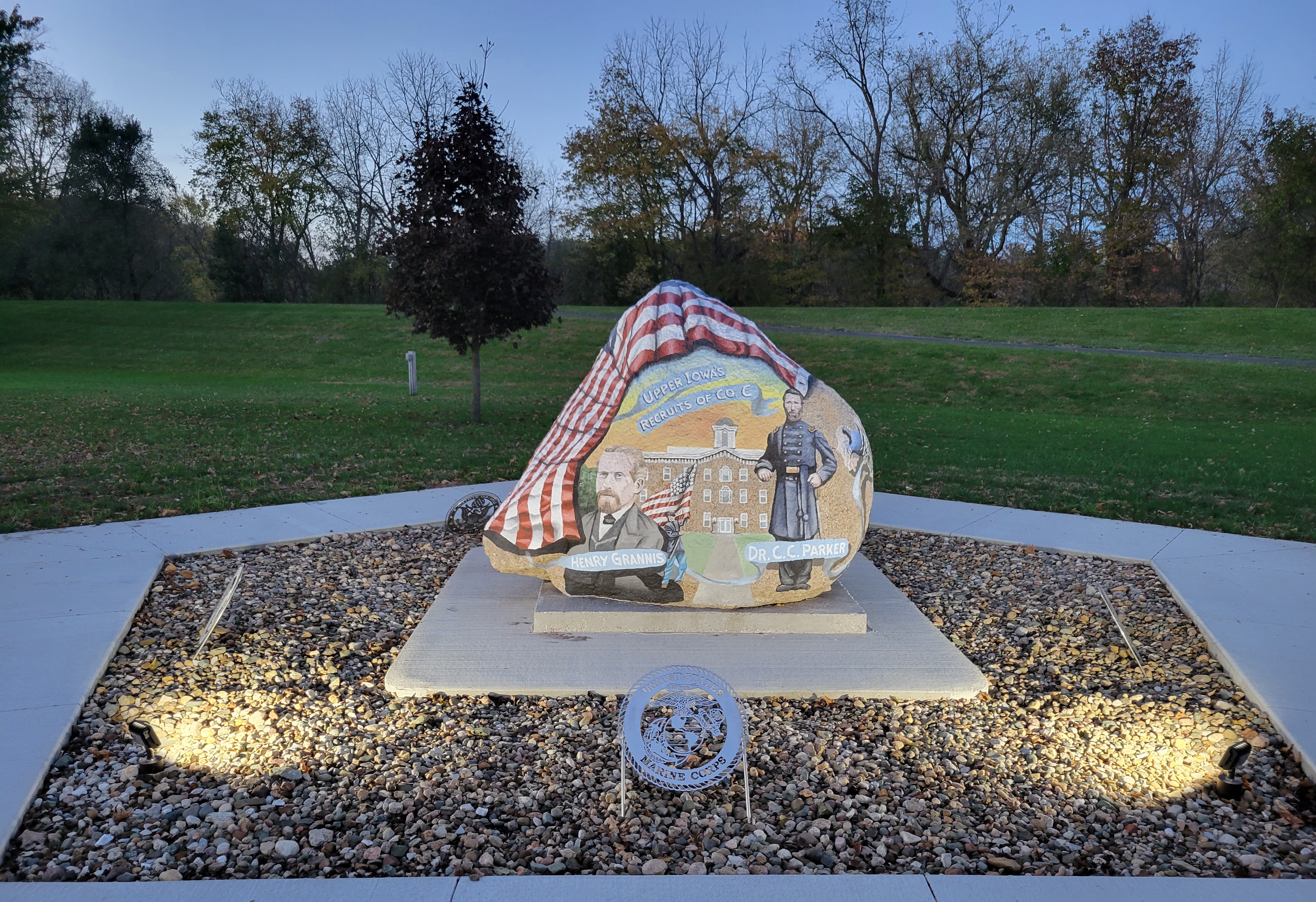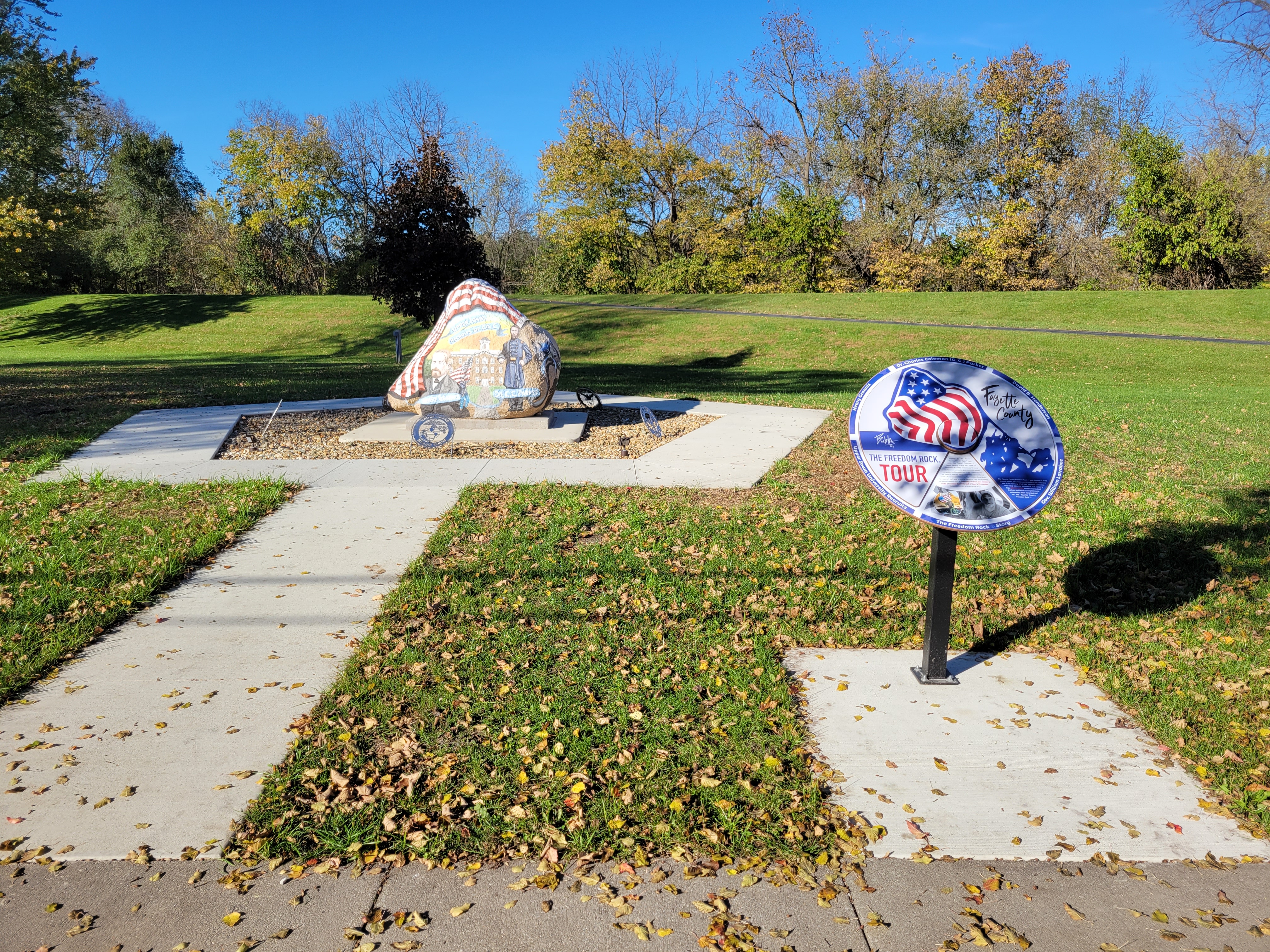
The Fayette County Freedom Rock was completed in 2020. A few additions around the rock were completed in the summer of 2021 which included an informational kiosk and metal medallions placed around the rock. A dedication of the rock took place during Watermelon Days, the city of Fayette's annual celebration, on September 11, 2021.
The artist, Ray "Bubba" Sorensen II, stayed just off campus and enjoyed the small town feel while he painted the Fayette County Freedom Rock. In fact, Bubba stayed just down the hill from Old Main, or the Alexander/Dickman Building at Upper Iowa University, which is featured on the Freedom Rock. The coloring of the rock reminded him of the exterior of the building, so he thought that would be a great use, and place for the rock to shine through. This famed, simple, Neoclassical style is one of the largest and best preserved native stone buildings still in use in Iowa.
Company C was primarily made up of students from Upper Iowa University. Early in the summer of 1861 the students organized a company for drill, calling themselves "University Recruits," and resolved: "That whenever the occasion demands it we will drop our books to fight our county's battles."
Henry J. Grannis was chosen unanimously to be Sergeant Color-Bearer for Company C, the 12th Iowa Volunteer Infantry and he proudly fulfilled his duty in 27 battles and skirmishes, holding the impressive position of being the only flag-bearer, Union or Confederate, to persevere the entirety of the Civil War without injury. It was said about him “that no man could exhibit more heroism than was exhibited by Henry Grannis, the farmer boy of Fayette county. In one battle, Tupelo, when his entire color-guard was either killed or wounded, he took up and held in the Southern breeze the State banner and the United States flag.” The flag he carried at the Battle of Shiloh was made by women at Upper Iowa.
Dr. Charles Coleman (C. C.) Parker, a doctor in Fayette, IA, served as a Civil War surgeon at the Battle of Shiloh, answering the call from friend and personal acquaintance President Lincoln. As the Regimental Surgeon of the 12th Iowa at Shiloh, Parker oversaw a battle that suffered enormous losses and disease. When illness and incapacity threatened his own life, Dr. Parker was forced to resign and returned to Fayette, where he taught the Natural Sciences at Upper Iowa.
William Larrabee was the 13th governor of the State of Iowa. In Iowa, Larrabee taught school for a few years, but soon after his arrival established himself as a successful miller, banker, and farmer in Clermont. He attempted to enlist at the outbreak of the Civil War, but was rejected on account of his disability. Although he couldn’t enlist, he helped recruit the locals for service and provided free flour to soldier’s wives (he owned a flour mill). He spent much of his life dedicated to supporting Union Veterans and their causes. As Governor, he fought for Veterans pensions and other programs in support of them.
David B Henderson was an Upper Iowa University student from Clermont, IA that was a Civil War veteran and ten-term Republican Congressman from Dubuque, Iowa, was the Speaker of the United States House of Representatives from 1899 to 1903. He was the first Congressman from west of the Mississippi River, the last Civil War veteran, the second foreign-born person (after Charles Frederick Crisp), and so far the only Iowan to serve as Speaker. He began his service by initially enlisting in the Union Army in 1861, as a private in Company C, 12th Iowa Volunteer Infantry Regiment. In the Battle of Fort Donelson, he was shot in the neck in the final charge over the breastworks. After returning to the Regiment in April 1862, he lost one foot and part of one leg at the Second Battle of Corinth in October 1862. He was discharged on February 26, 1863 due to his wounds, and returned to Iowa. He rejoined again as a Colonel of new 46th Iowa Volunteer Infantry Regiment, and was mustered out finally in 1864.
For those familiar with Bubba's work, he often includes eagles, but this time, because of the Civil War history connected with the university, he included a peacock (Upper Iowa’s mascot) to commemorate the service and sacrifice of those former students, staff and professors. Also, Old Glory flows over the top in honor of all who’ve served our country.
Visit www.thefreedomrock.com to find out more about the Freedom Rock Tour.





